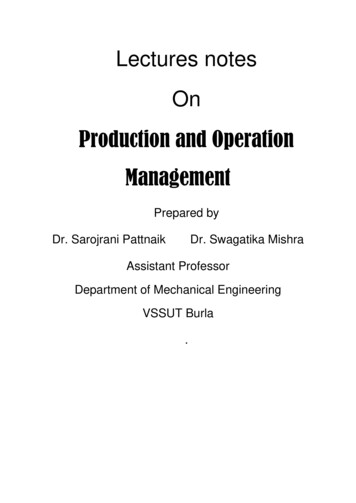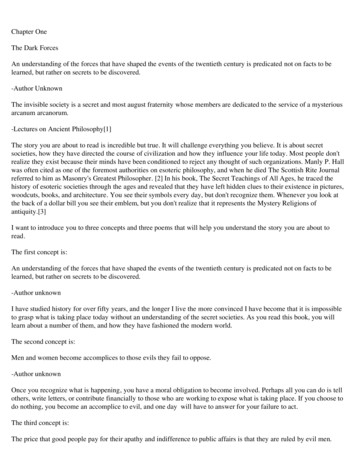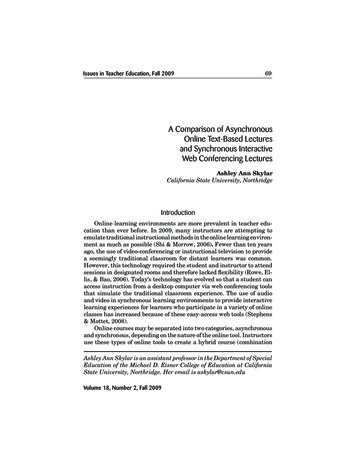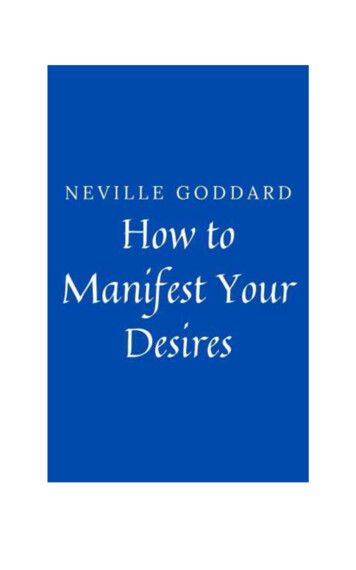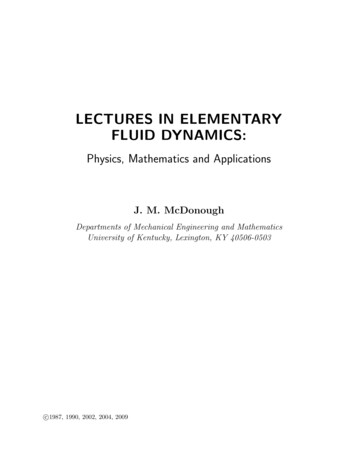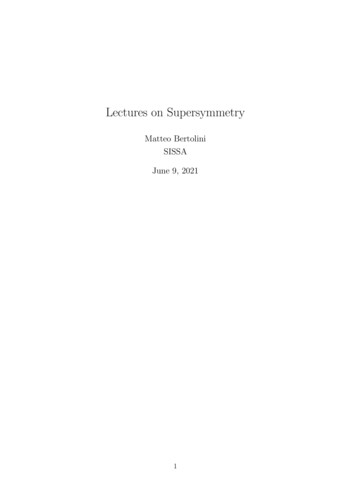
Transcription
Lectures on SupersymmetryMatteo BertoliniSISSAJune 9, 20211
ForewordThis is a write-up of a course on Supersymmetry I have been giving for severalyears to first year PhD students attending the curriculum in Theoretical ParticlePhysics at SISSA, the International School for Advanced Studies of Trieste.There are several excellent books on supersymmetry and many very good lecturecourses are available on the archive. The ambition of this set of notes is not to addanything new in this respect, but to offer a set of hopefully complete and selfconsistent lectures, which start from the basics and arrive to some of the morerecent and advanced topics. The price to pay is that the material is pretty huge.The advantage is to have all such material in a single, possibly coherent file, andthat no prior exposure to supersymmetry is required.There are many topics I do not address and others I only briefly touch. Inparticular, I discuss only rigid supersymmetry (mostly focusing on four space-timedimensions), while no reference to supergravity is given. Moreover, this is a theoretical course and phenomenological aspects are only briefly sketched. One onlychapter is dedicated to present basic phenomenological ideas, including a bird eyesview on models of gravity and gauge mediation and their properties, but a thoroughdiscussion of phenomenological implications of supersymmetry would require muchmore.There is no bibliography at the end of the file. However, each chapter contains itsown bibliography where the basic references (mainly books and/or reviews availableon-line) I used to prepare the material are reported – including explicit reference tocorresponding pages and chapters, so to let the reader have access to the originalfont (and to let me give proper credit to authors).I hope this effort can be of some help to as many students as possible!Disclaimer: I expect the file to contain many typos and errors. Everybody iswelcome to let me know them, dialing at matteo.bertolini@sissa.it. Your helpwill be very much appreciated.2
Contents1 Supersymmetry: a bird eyes view71.1What is supersymmetry? . . . . . . . . . . . . . . . . . . . . . . . . .81.2What is supersymmetry useful for? . . . . . . . . . . . . . . . . . . .91.3Some useful references . . . . . . . . . . . . . . . . . . . . . . . . . . 182 The supersymmetry algebra222.1Lorentz and Poincaré groups . . . . . . . . . . . . . . . . . . . . . . . 222.2Spinors and representations of the Lorentz group2.3The supersymmetry algebra . . . . . . . . . . . . . . . . . . . . . . . 292.4Exercises . . . . . . . . . . . . . . . . . . . . . . . . . . . . . . . . . . 37. . . . . . . . . . . 253 Representations of the supersymmetry algebra383.1Massless supermultiplets . . . . . . . . . . . . . . . . . . . . . . . . . 403.2Massive supermultiplets . . . . . . . . . . . . . . . . . . . . . . . . . 473.3Representation on fields: a first try . . . . . . . . . . . . . . . . . . . 533.4Exercises . . . . . . . . . . . . . . . . . . . . . . . . . . . . . . . . . . 564 Superspace and superfields574.1Superspace as a coset . . . . . . . . . . . . . . . . . . . . . . . . . . . 574.2Superfields as fields in superspace . . . . . . . . . . . . . . . . . . . . 604.3Supersymmetric invariant actions - general philosophy . . . . . . . . . 644.4Chiral superfields . . . . . . . . . . . . . . . . . . . . . . . . . . . . . 654.5Real (aka vector) superfields . . . . . . . . . . . . . . . . . . . . . . . 684.6(Super)Current superfields . . . . . . . . . . . . . . . . . . . . . . . . 704.74.6.1Internal symmetry current superfields . . . . . . . . . . . . . . 714.6.2Supercurrent superfields . . . . . . . . . . . . . . . . . . . . . 72Exercises . . . . . . . . . . . . . . . . . . . . . . . . . . . . . . . . . . 755 Supersymmetric actions: minimal supersymmetry5.176N 1 Matter actions . . . . . . . . . . . . . . . . . . . . . . . . . . 765.1.1Non-linear sigma model I . . . . . . . . . . . . . . . . . . . . . 833
5.25.35.4N 1 SuperYang-Mills . . . . . . . . . . . . . . . . . . . . . . . . . 87N 1 Gauge-matter actions . . . . . . . . . . . . . . . . . . . . . . . 915.3.1Classical moduli space: examples . . . . . . . . . . . . . . . . 955.3.2The SuperHiggs mechanism . . . . . . . . . . . . . . . . . . . 1025.3.3Non-linear sigma model II . . . . . . . . . . . . . . . . . . . . 104Exercises . . . . . . . . . . . . . . . . . . . . . . . . . . . . . . . . . . 1066 Theories with extended supersymmetry6.1108N 2 supersymmetric actions . . . . . . . . . . . . . . . . . . . . . . 1086.1.1Non-linear sigma model III . . . . . . . . . . . . . . . . . . . . 1116.2N 4 supersymmetric actions . . . . . . . . . . . . . . . . . . . . . . 1136.3On non-renormalization theorems . . . . . . . . . . . . . . . . . . . . 1147 Supersymmetry breaking1227.1Vacua in supersymmetric theories . . . . . . . . . . . . . . . . . . . . 1227.2Goldstone theorem and the goldstino . . . . . . . . . . . . . . . . . . 1247.3F-term breaking . . . . . . . . . . . . . . . . . . . . . . . . . . . . . . 1267.4Pseudomoduli space: quantum corrections . . . . . . . . . . . . . . . 1377.5D-term breaking . . . . . . . . . . . . . . . . . . . . . . . . . . . . . . 1417.6Indirect criteria for supersymmetry breaking . . . . . . . . . . . . . . 1447.77.6.1Supersymmetry breaking and global symmetries . . . . . . . . 1447.6.2Topological constraints: the Witten Index . . . . . . . . . . . 1477.6.3Genericity and metastability . . . . . . . . . . . . . . . . . . . 153Exercises . . . . . . . . . . . . . . . . . . . . . . . . . . . . . . . . . . 1548 Mediation of supersymmetry breaking1568.1Towards dynamical supersymmetry breaking . . . . . . . . . . . . . . 1568.2The Supertrace mass formula . . . . . . . . . . . . . . . . . . . . . . 1588.3Beyond Minimal Supersymmetric Standard Model . . . . . . . . . . . 1608.4Spurions, soft terms and the messenger paradigm . . . . . . . . . . . 1618.5Mediating the breaking . . . . . . . . . . . . . . . . . . . . . . . . . . 1648.5.1Gravity mediation . . . . . . . . . . . . . . . . . . . . . . . . 1654
8.5.28.6Gauge mediation . . . . . . . . . . . . . . . . . . . . . . . . . 168Exercises . . . . . . . . . . . . . . . . . . . . . . . . . . . . . . . . . . 1729 Non-perturbative effects and holomorphy1749.1Instantons and anomalies in a nutshell . . . . . . . . . . . . . . . . . 1749.2’t Hooft anomaly matching condition . . . . . . . . . . . . . . . . . . 1789.3Holomorphy . . . . . . . . . . . . . . . . . . . . . . . . . . . . . . . . 1809.4Holomorphy and non-renormalization theorems . . . . . . . . . . . . 1829.5Holomorphic decoupling . . . . . . . . . . . . . . . . . . . . . . . . . 1929.6Exercises . . . . . . . . . . . . . . . . . . . . . . . . . . . . . . . . . . 19510 Supersymmetric gauge dynamics: N 119610.1 Confinement and mass gap in QCD, YM and SYM . . . . . . . . . . 19610.2 Phases of gauge theories: examples . . . . . . . . . . . . . . . . . . . 20610.2.1 Coulomb phase and free phase . . . . . . . . . . . . . . . . . . 20710.2.2 Continuously connected phases . . . . . . . . . . . . . . . . . 20810.3 N 1 SQCD: perturbative analysis . . . . . . . . . . . . . . . . . . . . 20910.4 N 1 SQCD: non-perturbative dynamics . . . . . . . . . . . . . . . . 21110.4.1 Pure SYM: gaugino condensation . . . . . . . . . . . . . . . . 21210.4.2 SQCD for F N : the ADS superpotential . . . . . . . . . . . 21410.4.3 Integrating in and out: the linearity principle . . . . . . . . . 22010.4.4 SQCD for F N and F N 1 . . . . . . . . . . . . . . . . 22410.4.5 Conformal window . . . . . . . . . . . . . . . . . . . . . . . . 23110.4.6 Electric-magnetic duality (aka Seiberg duality) . . . . . . . . . 23410.5 The phase diagram of N 1 SQCD . . . . . . . . . . . . . . . . . . . . 24210.6 Exercises . . . . . . . . . . . . . . . . . . . . . . . . . . . . . . . . . . 24311 Dynamical supersymmetry breaking24611.1 Calculable and non-calculable models: generalities . . . . . . . . . . . 24611.2 The one GUT family SU(5) model . . . . . . . . . . . . . . . . . . . . 24911.3 The 3-2 model: instanton driven SUSY breaking . . . . . . . . . . . . 25111.4 The 4-1 model: gaugino condensation driven SUSY breaking . . . . . 2575
11.5 The ITIY model: SUSY breaking with classical flat directions . . . . 25911.6 DSB into metastable vacua. A case study: massive SQCD . . . . . . 26211.6.1 Summary of basic results . . . . . . . . . . . . . . . . . . . . . 26211.6.2 Massive SQCD in the free magnetic phase: electric description 26411.6.3 Massive SQCD in the free magnetic phase: magnetic description26511.6.4 Summary of the physical picture . . . . . . . . . . . . . . . . . 27312 Supersymmetric gauge dynamics: extended supersymmetry27612.1 Low energy effective actions: classical and quantum . . . . . . . . . . 27612.1.1 N 2 effective actions . . . . . . . . . . . . . . . . . . . . . . 27812.1.2 N 4 effective actions . . . . . . . . . . . . . . . . . . . . . . 28412.2 Monopoles, dyons and electric-magnetic duality . . . . . . . . . . . . 28512.3 Seiberg-Witten theory . . . . . . . . . . . . . . . . . . . . . . . . . . 29412.3.1 N 2 SU (2) pure SYM . . . . . . . . . . . . . . . . . . . . . 29612.3.2 Intermezzo: confinement by monopole condensation . . . . . . 30712.3.3 Seiberg-Witten theory: generalizations . . . . . . . . . . . . . 30912.4 N 4: Montonen-Olive duality . . . . . . . . . . . . . . . . . . . . . 3166
1Supersymmetry: a bird eyes viewComing years could represent a new era of unexpected and exciting discoveriesin high energy physics, since a long time. For one thing, the CERN Large HadronCollider (LHC) has been operating for some time, now, and many experimental datahave already being collected. So far, the greatest achievement of the LHC has beenthe discovery of the missing building block of the Standard Model, the Higgs particle(or, at least, a particle which most likely is the Standard Model Higgs particle). Onthe other hand, no direct evidence of new physics beyond the Standard Model hasbeen found, yet. Still, there are several reasons to believe that new physics shouldin fact show-up at, or about, the TeV scale.The most compelling scenario for physics beyond the Standard Model (BSM) issupersymmetry. For this reason, knowing what is supersymmetry is rather important for a high energy physicist, nowadays. Understanding how supersymmetry canbe realized (and then spontaneously broken) in Nature, is in fact one of the mostimportant challenges theoretical high energy physics has to confront with. Thiscourse provides an introduction to such fascinating subject.Before entering into any detail, in this first lecture we just want to give a briefoverview on what is supersymmetry and why is it interesting to study it. The restof the course will try to provide (much) more detailed answers to these two basicquestions.Disclaimer: The theory we are going to focus our attention in the (more than)three-hundred pages which follow, can be soon proved to be the correct mathematicalframework where to understand high energy physics at the TeV scale, and become apiece of basic knowledge any particle physicist should have. But it can very well bethat BSM physics is more subtle and Nature not so kind to make supersymmetry berealized at low enough energy that we can make experiment of. Or, it can also bethat all this will eventually turn out to be just a purely academic exercise about atheory that nothing has to do with Nature. An elegant way mankind has worked outto describe in an unique and self-consistent way elementary particle physics, whichhowever is not the one chosen by Nature (but can we ever safely say so?). As I willbriefly outline below, and discuss in more detail in the second part of this course,even in such a scenario. studying supersymmetry and its fascinating propertiesmight still be helpful and instructive in many respects.7
1.1What is supersymmetry?Supersymmetry (SUSY) is a space-time symmetry mapping particles and fields ofinteger spin (bosons) into particles and fields of half integer spin (fermions), andviceversa. The generators Q act asQ F ermioni Bosoniand viceversa(1.1)From its very definition, this operator has two obvious but far-reaching propertiesthat can be summarized as follows: It changes the spin of a particle (meaning that Q transforms as a spin-1/2particle) and hence its space-time properties. This is why supersymmetry isnot an internal symmetry but a space-time symmetry. In a theory where supersymmetry is realized, each one-particle state has atleast a superpartner. Therefore, in a SUSY world, instead of single particlestates, one has to deal with (super)multiplets of particle states.Supersymmetry generators have specific commutation properties with other generators. In particular: Q commutes with translations and internal quantum numbers (e.g. gauge andglobal symmetries), but it does not commute with Lorentz generators[Q, Pµ ] 0 ,[Q, G] 0 ,[Q, Mµν ] 6 0 .(1.2)This implies that particles belonging to the same supermultiplet have differentspin but same mass and same quantum numbers.A supersymmetric field theory is a set of fields and a Lagrangian which exhibit such asymmetry. As ordinary field theories, supersymmetric theories describe particles andinteractions between them: SUSY manifests itself in the specific particle spectruma theory enjoys, and in the way particles interact between themselves.A supersymmetric model which is covariant under general coordinate transformations is called supergravity (SUGRA) model. In this respect, a non-trivial fact,which again comes from the algebra, in particular from the (anti)commutation relation{Q, Q̄} Pµ ,(1.3)8
is that having general coordinate transformations is equivalent to have local SUSY,the gauge mediator being a spin 3/2 particle, the gravitino. Hence local supersymmetry and General Relativity are intimately tied together.One can have theories with different number of S
Foreword This is a write-up of a course on Supersymmetry I have been giving for several years to rst year PhD students attending the curriculum in Theoretical Particle
